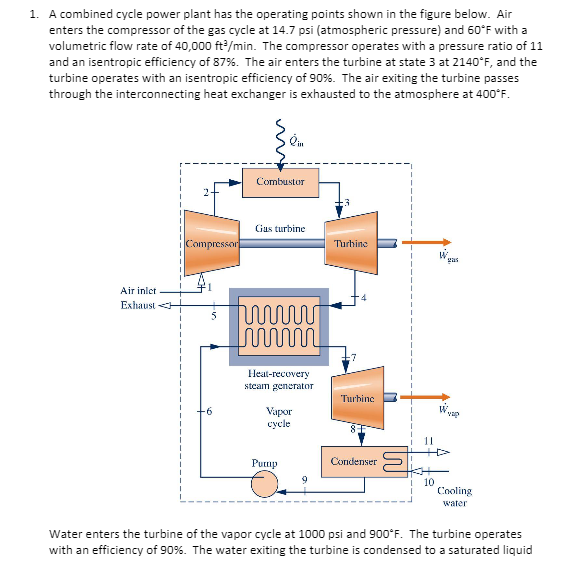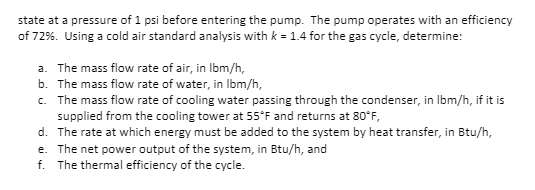A combined cycle power plant has the operating points shown in the figure below. Air enters the compressor of the gas cycle at 14.7 psi (atmospheric pressure) and 60*F with a volumetric flow rate of 40,000 ft/min. The compressor operates with a pressure ratio of 11 and an isentropic efficiency of 87%. The air enters the turbine at state 3 at 2140*F, and the turbine operates with an isentropic efficiency of 90%. The air exiting the turbine passes through the interconnecting heat exchanger is exhausted to the atmosphere at 400*F. Combustor Cias turbine Compressor Turbino Air inlet Exhaust Heat-recovery steam generator Turbine Vapor cycle Putup Соndenser 10 Cooling water Water enters the turbine of the vapor cycle at 1000 psi and 900*F. The turbine operates with an efficiency of 90%. The water exiting the turbine is condensed to a saturated liquid
A combined cycle power plant has the operating points shown in the figure below. Air enters the compressor of the gas cycle at 14.7 psi (atmospheric pressure) and 60*F with a volumetric flow rate of 40,000 ft/min. The compressor operates with a pressure ratio of 11 and an isentropic efficiency of 87%. The air enters the turbine at state 3 at 2140*F, and the turbine operates with an isentropic efficiency of 90%. The air exiting the turbine passes through the interconnecting heat exchanger is exhausted to the atmosphere at 400*F. Combustor Cias turbine Compressor Turbino Air inlet Exhaust Heat-recovery steam generator Turbine Vapor cycle Putup Соndenser 10 Cooling water Water enters the turbine of the vapor cycle at 1000 psi and 900*F. The turbine operates with an efficiency of 90%. The water exiting the turbine is condensed to a saturated liquid
Elements Of Electromagnetics
7th Edition
ISBN:9780190698614
Author:Sadiku, Matthew N. O.
Publisher:Sadiku, Matthew N. O.
ChapterMA: Math Assessment
Section: Chapter Questions
Problem 1.1MA
Related questions
Question
100%
Question on D-F
Also why not assume that P1=P4?

Transcribed Image Text:1. A combined cycle power plant has the operating points shown in the figure below. Air
enters the compressor of the gas cycle at 14.7 psi (atmospheric pressure) and 60ʻF with a
volumetric flow rate of 40,000 ft/min. The compressor operates with a pressure ratio of 11
and an isentropic efficiency of 87%. The air enters the turbine at state 3 at 2140°F, and the
turbine operates with an isentropic efficiency of 90%. The air exiting the turbine passes
through the interconnecting heat exchanger is exhausted to the atmosphere at 400*F.
Combustor
Cias turbine
Compressor
Turhine
gas
Air inlet
Exhaust
Heat-recovery
steam generator
Turhine
Vapor
суcle
11
Putmp
Condenser
10
Cooling
water
Water enters the turbine of the vapor cycle at 1000 psi and 900°F. The turbine operates
with an efficiency of 90%. The water exiting the turbine is condensed to a saturated liquid

Transcribed Image Text:state at a pressure of 1 psi before entering the pump. The pump operates with an efficiency
of 72%. Using a cold air standard analysis with k = 1.4 for the gas cycle, determine:
a. The mass flow rate of air, in Ibm/h,
b. The mass flow rate of water, in Ibm/h,
c. The mass flow rate of cooling water passing through the condenser, in Ibm/h, if it is
supplied from the cooling tower at 55*F and returns at 80*F,
d. The rate at which energy must be added to the system by heat transfer, in Btu/h,
e. The net power output of the system, in Btu/h, and
f. The thermal efficiency of the cycle.
Expert Solution
This question has been solved!
Explore an expertly crafted, step-by-step solution for a thorough understanding of key concepts.
This is a popular solution!
Trending now
This is a popular solution!
Step by step
Solved in 5 steps with 15 images

Knowledge Booster
Learn more about
Need a deep-dive on the concept behind this application? Look no further. Learn more about this topic, mechanical-engineering and related others by exploring similar questions and additional content below.Recommended textbooks for you

Elements Of Electromagnetics
Mechanical Engineering
ISBN:
9780190698614
Author:
Sadiku, Matthew N. O.
Publisher:
Oxford University Press

Mechanics of Materials (10th Edition)
Mechanical Engineering
ISBN:
9780134319650
Author:
Russell C. Hibbeler
Publisher:
PEARSON

Thermodynamics: An Engineering Approach
Mechanical Engineering
ISBN:
9781259822674
Author:
Yunus A. Cengel Dr., Michael A. Boles
Publisher:
McGraw-Hill Education

Elements Of Electromagnetics
Mechanical Engineering
ISBN:
9780190698614
Author:
Sadiku, Matthew N. O.
Publisher:
Oxford University Press

Mechanics of Materials (10th Edition)
Mechanical Engineering
ISBN:
9780134319650
Author:
Russell C. Hibbeler
Publisher:
PEARSON

Thermodynamics: An Engineering Approach
Mechanical Engineering
ISBN:
9781259822674
Author:
Yunus A. Cengel Dr., Michael A. Boles
Publisher:
McGraw-Hill Education

Control Systems Engineering
Mechanical Engineering
ISBN:
9781118170519
Author:
Norman S. Nise
Publisher:
WILEY

Mechanics of Materials (MindTap Course List)
Mechanical Engineering
ISBN:
9781337093347
Author:
Barry J. Goodno, James M. Gere
Publisher:
Cengage Learning

Engineering Mechanics: Statics
Mechanical Engineering
ISBN:
9781118807330
Author:
James L. Meriam, L. G. Kraige, J. N. Bolton
Publisher:
WILEY